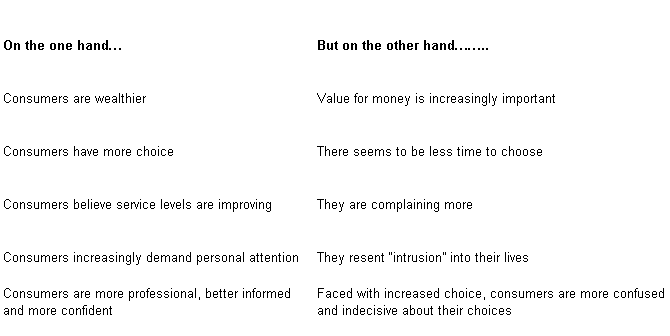|
|
|
New Research from the Henley Centre for Economic Forecasting
Recent research by The Henley Centre has identified a series of paradoxes in
summarising key UK consumer trends
Stronger Disposable Incomes Fuel Long-Term Growth in Spending The evidence that consumers are wealthier is strong. UK consumer’s real incomes have tripled in the last 40 years, and we are 70% better off than we were in 1979. On average, across the total UK population, some 47% of household expenditure is now classified as “discretionary” and is worth some £380 billion. As incomes have risen, the proportion spent on household expenditure has fallen to a stage where consumers now spend as much on leisure goods and services (17% of household spend) as they do on food and non-alcoholic drinks. A high proportion of consumers (77% in total, and 85% of Social Class AB) report that “there are no material comforts missing from their life”. Accordingly, certain segments of consumer spending – particularly leisure services – have enjoyed strong growth in recent years. The broad leisure market, estimated to be worth some £80 billion, has grown by around 7% per annum in the last five years. Social Change Creates New Pressures Whilst overall consumer spending on leisure is growing strongly, social change is influencing the market segments and products that benefit most from, or which are do not share overall market growth. In particular, the traditional structures of life: households, gender distinctions, the working day, respect for traditional cultural institutions and participation in traditional communities, are all shifting, creating new patterns of demand. How are these social changes, affecting the way consumers behave? An important effect is that for many consumers, “time” has become a currency. According to The Henley Centre the search for “value for time” has become as important as “value for money”. Consumers are searching for ways to save time on necessary activities and “invest time” in quality leisure experiences. As consumers are working longer hours, they are increasingly prepared to pay money to avoid activities that soak up the remaining available time (for example the employment of household cleaners, grocery delivery services) and are searching out leisure activities where they can “chill”. The constraint on time is encouraging consumers to dabble with leisure activities. Increasing demand for lunchtime “try-out” courses is a good example, as is the increase in short breaks as compared with the more traditional, longer holiday break. Consumers are also demanding more flexible opening hours and pricing options, less variation and improved standards in the quality of leisure facilities and products. They also want the “high points” or “perfect moments” with as little hassle as possible. And they are demanding more complex, more individual leisure products – helping them differentiate themselves from the crowd. This means good news for more specialist leisure companies, particularly those that can “tailor” the leisure product to meet individual needs. But it spells danger for more mainstream operators who rely on high volumes of consumers buying a more standard product (such as a packaged short-haul beach holiday) to deliver low average costs and prices. Interestingly, researchers suggest that UK consumers are increasingly refusing to “act their age” – an important finding for leisure companies contemplating which products or services to offer the [apparently] older generation. Not only must leisure companies adjust to the changing numbers of consumers defined by actual age, social class and household composition. They must take account of consumers who are now defying the traditional categorisation. What price now for a new holiday brand – the Club 18-65 Holiday?
Jim Riley
|
|










